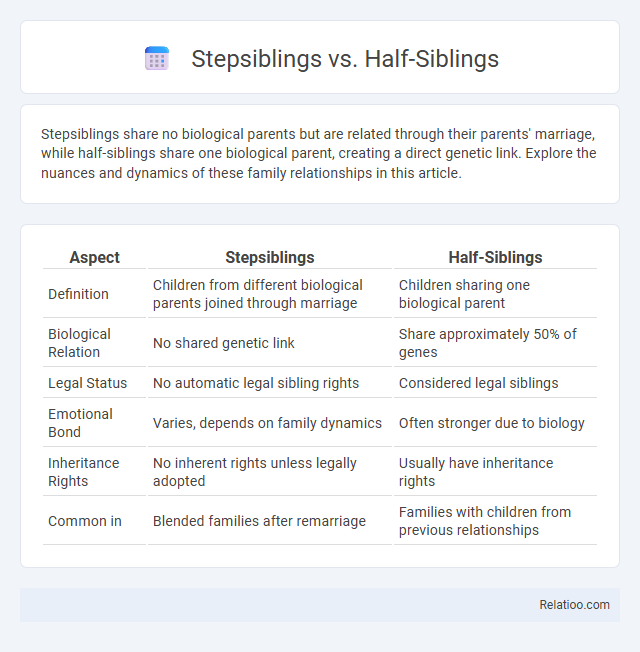Stepsiblings share no biological parents but are related through their parents' marriage, while half-siblings share one biological parent, creating a direct genetic link. Explore the nuances and dynamics of these family relationships in this article.
Table of Comparison
| Aspect | Stepsiblings | Half-Siblings |
|---|---|---|
| Definition | Children from different biological parents joined through marriage | Children sharing one biological parent |
| Biological Relation | No shared genetic link | Share approximately 50% of genes |
| Legal Status | No automatic legal sibling rights | Considered legal siblings |
| Emotional Bond | Varies, depends on family dynamics | Often stronger due to biology |
| Inheritance Rights | No inherent rights unless legally adopted | Usually have inheritance rights |
| Common in | Blended families after remarriage | Families with children from previous relationships |
Understanding the Basics: Stepsiblings vs Half-Siblings
Stepsiblings share no biological connection but become family through the marriage of their respective parents, while half-siblings share one biological parent, creating a genetic link. Understanding the distinction helps clarify family dynamics and legal considerations regarding inheritance, custody, and emotional bonds. Your awareness of these differences can reduce social stigma by promoting acceptance and empathy within blended families.
Definitions: What Makes Someone a Stepsibling?
Stepsiblings are individuals who become siblings through the marriage of their respective parents, without sharing biological or genetic ties, whereas half-siblings share one biological parent. Social stigma around stepsiblings often arises from misconceptions about family bonds and legitimacy, despite many blended families forming strong, supportive relationships. Understanding the clear definition of stepsiblings helps you navigate and challenge any negative perceptions linked to blended family dynamics.
Definitions: What Makes Someone a Half-Sibling?
Half-siblings share one biological parent, either mother or father, resulting from relationships where a single parent has children with different partners. Stepsiblings, in contrast, are linked through the marriage of their respective parents and do not share biological ties. Social stigma often influences perceptions of these family dynamics, but the defining factor for half-siblings remains the genetic connection through one common parent.
Family Structures: How Stepsiblings and Half-Siblings Form
Stepsiblings form through the marriage or partnership of two individuals who each have children from previous relationships, creating a blended family without blood relation. Half-siblings share one biological parent, resulting in genetic ties that influence family dynamics and inheritance rights. Your understanding of these family structures can help challenge social stigma by recognizing the legitimacy and complexity of diverse familial bonds.
Legal Differences Between Stepsiblings and Half-Siblings
Stepsiblings do not share biological parents and have no automatic legal rights or inheritance claims between each other, unlike half-siblings who share one biological parent and are legally recognized as close relatives with associated rights. Legal distinctions impact custody, inheritance, and family law responsibilities, as half-siblings often have enforceable entitlements under laws governing blood relations, while stepsiblings' legal connections rely primarily on the marital status of their parents. Courts typically treat half-siblings as recognized family members, whereas stepsiblings require formal adoption or legal agreements for similar rights or obligations.
Emotional Bonds: Comparing Relationships
Emotional bonds between stepsiblings and half-siblings vary significantly due to genetic ties and shared family environments, with half-siblings often experiencing stronger innate connections. You may find that stepsiblings rely more on developing trust and mutual experiences to overcome social stigma and build meaningful relationships. Understanding these dynamics helps navigate the emotional complexities unique to blended families, fostering empathy and stronger familial bonds.
Shared Genetics: Half-Siblings vs Stepsiblings
Half-siblings share approximately 25% of their genetic material due to having one common biological parent, which influences their potential for inherited traits and familial medical history. Stepsiblings, in contrast, do not share genetic ties as their relationship is established through marriage rather than biology, often impacting societal perceptions and social stigma differently compared to half-siblings. The presence or absence of shared genetics plays a significant role in the way half-siblings and stepsiblings experience family dynamics and external social attitudes.
Living Arrangements and Daily Life
Stepsiblings and half-siblings often navigate different living arrangements, with half-siblings typically sharing a biological parent and residing more permanently together, influencing a stronger familial bond in daily life. Stepsiblings may experience varied household dynamics due to blended family complexities, leading to diverse social interactions and roles within daily routines. Social stigma can impact both relationships, affecting acceptance and integration in family settings, often shaping emotional connections and the sense of belonging in everyday living.
Common Challenges Faced by Stepsiblings and Half-Siblings
Stepsiblings and half-siblings often navigate complex family dynamics that include identity confusion, loyalty conflicts, and challenges in establishing strong emotional bonds. You may encounter social stigma rooted in traditional views of family structures, which can affect acceptance both within the family and in broader social contexts. Understanding and addressing these common challenges through open communication and empathy fosters healthier relationships and reduces the impact of external judgments.
Tips for Building Strong Blended Family Relationships
Building strong blended family relationships involves open communication, setting clear boundaries, and fostering mutual respect among stepsiblings and half-siblings to overcome social stigma. Encouraging shared activities and creating family traditions can promote bonding and reduce feelings of exclusion or rivalry. Seeking family therapy or counseling provides valuable tools to navigate emotional challenges and strengthens connections in blended family dynamics.

Infographic: Stepsiblings vs Half-Siblings
 relatioo.com
relatioo.com